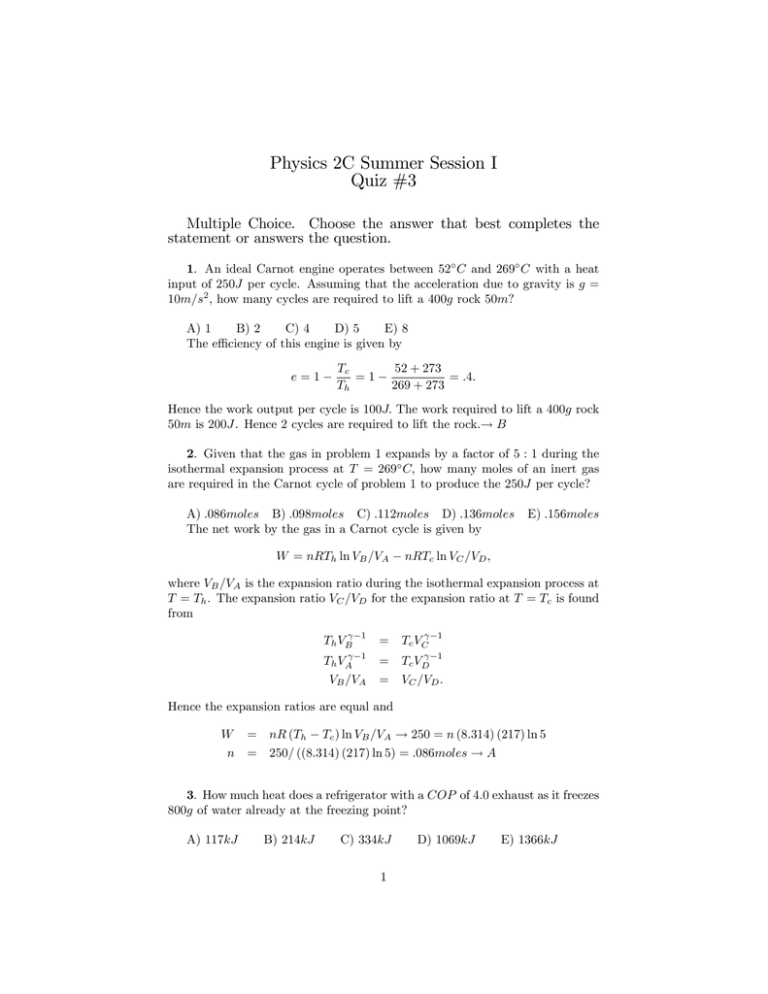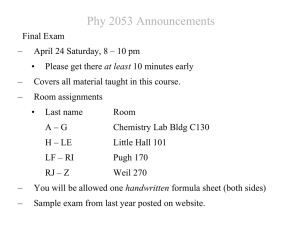Physics 2C Summer Session I Quiz #3 statement or answers the question.
advertisement

Physics 2C Summer Session I Quiz #3 Multiple Choice. Choose the answer that best completes the statement or answers the question. 1. An ideal Carnot engine operates between 52 C and 269 C with a heat input of 250J per cycle. Assuming that the acceleration due to gravity is g = 10m=s2 ; how many cycles are required to lift a 400g rock 50m? A) 1 B) 2 C) 4 D) 5 E) 8 The e¢ ciency of this engine is given by e=1 Tc =1 Th 52 + 273 = :4: 269 + 273 Hence the work output per cycle is 100J: The work required to lift a 400g rock 50m is 200J. Hence 2 cycles are required to lift the rock.! B 2. Given that the gas in problem 1 expands by a factor of 5 : 1 during the isothermal expansion process at T = 269 C; how many moles of an inert gas are required in the Carnot cycle of problem 1 to produce the 250J per cycle? A) :086moles B) :098moles C) :112moles D) :136moles The net work by the gas in a Carnot cycle is given by W = nRTh ln VB =VA E) :156moles nRTc ln VC =VD ; where VB =VA is the expansion ratio during the isothermal expansion process at T = Th . The expansion ratio VC =VD for the expansion ratio at T = Tc is found from T h VB 1 T h VA 1 VB =VA = Tc VC 1 = Tc VD 1 = VC =VD : Hence the expansion ratios are equal and W n = nR (Th Tc ) ln VB =VA ! 250 = n (8:314) (217) ln 5 = 250= ((8:314) (217) ln 5) = :086moles ! A 3. How much heat does a refrigerator with a COP of 4:0 exhaust as it freezes 800g of water already at the freezing point? A) 117kJ B) 214kJ C) 334kJ 1 D) 1069kJ E) 1366kJ The heat exhausted to the high temperature reservoir is found from COP = Qh = Qc Qc = ! COP Qh = (COP + 1) Qc W Qh Qc COP + 1 5 Qc = :8 334kJ = 334kJ ! C COP 4 4. What is the entropy increase during an adiabatic free expansion from an initial volume of Vi = 2L to a …nal volume of Vf = 10L for :36 moles of an ideal diatomic gas at an initial temperature T = 100 C? A) 2:44J=K B) 4:82J=K C) 7:23J=K The entropy increase is found from s= P V nRT ln (Vf =Vi ) Q = = = :36 T T T D) 12:0J=K E) 0J=K 8:314 ln (5) = 4:82J=K ! B : 5. At the surface of Titan (Saturn’s largest moon) the atmosphere is essentially all nitrogen gas, (N2 ) ; which has a pressure of P = 1:5 105 P a and a molar density of n=V = :014mol=L: What is the speed of sound in this atmosphere (note that atomic nitrogen has an atomic number of A = 14)? A) 23:1km=s B) 1035m=s C) 732km=s D) 799m=s E) 732m=s The temperature on the surface of Titan is found from the ideal gas law, P V = nRT ! RT = P V =n The speed of sound is p p p vs = P= = kT =m = RT =mmol : From the expression for RT we …nd p p P V =nmmol = 1:4 vs = vs = 732m=s ! E 1:5 105 = (:014 103 28 10 3) 6. At a distance of 4m from a sound source the intensity level is 76dB: What is the intensity level (in dB) at a distance of 10m? A) 68dB B) 58dB C) 8dB D) 18dB E) 60dB The intensity falls o¤ as 1=r2 : Hence I=Io = :42 = :16: The change in dB is = 10 log I=Io = 10 log (:16) = Hence the intensity at 10m is 76dB 8dB 8dB = 68:0dB ! A 2 7. One end of a 700g nylon rope is suspended at the top of a vertical mine shaft (analogous to a well) that is 60m deep. The rope is attached to a box of mineral samples with mass 110kg. Assuming an acceleration due to gravity of g = 10m=s2 ; how long does it take for a transverse wave to propagate from the top to the bottom of the rope? A) 5:12s B) 265ms C) 307ms D) 6:17s E) 195ms The speed of a wave on the rope is p p v = T = = 110 10= (:7=60) = 307m=s The propragation time is t = `=v = 60=307 = 195ms ! E 8. What is the frequency of the third harmonic on the nylon rope described in problem 6? 3 A) 40Hz B) 4:0Hz C) 5:1Hz D) 7:7Hz E) 15:4Hz The wavelength of the mth harmonic is determined from m = 2`=m. Hence = 2(60)=3 = 40m: This means that the frequency of this harmonic is f3 = v= 3 = 307=40 = 7:675Hz ! D 9. Consider the …gure that plots an harmonic wave as a function of position (a) at t = 0 and as a function of time (b) at x = 3 =2 where is the wavelength of the wave. The mathematical expression for this wave is Problem 9 3 A) y = 2 sin (x 2t) =3 B) y = 2 sin 2 (x + 2t) =3 C) y = 2 sin 2 (x + 2t) =3 D) y = 2 sin 2 (x 2t) =3 E) y = 2 cos 2 (x + 2t + 3=2) =3 The most general expression for a simple harmonic wave is y = A sin (kx !t + ) = A sin (2 (x= t=T ) + ) : : From the …gures we know that A = 2; = 3; and T = 1:5: From …gure a (t = 0) y = 2 sin (2 x=3 + ) ! = 0 When x = 3 =2 the waveform becomes y = A sin (3 2 t=T ) = A sin ( 2 t=T ) ! +sign Hence the waveform is y = 2 sin 2 (x + 2t) ! C 3 10. Given the wave train along a string shown in Figure 3 obtain an expression for the total energy in this wave train, in terms of the tension, F , the wave amplitude, A, and the wavelength : Problem 10 A) E = 2 A2 F= B) E = 2 2 A2 F= C) E = 4 2 A2 F= D) E = 2 E) E = 2 AF The total energy is given by Z Z 4 2 E = P dt = F kA sin2 (kx !t) (!dt) = 2 F kA2 0 E = 2 (2 ) F A2 = = 4 2 A2 F= ! C Some useful constants and expressions Universal gas constant speci…c heat (water) heat of fusion (water) power transmitted along a wave 4 R = 8:314J=Kmol c = 4184J=kgK Lf = 334kJ=kg P = F !kA2 sin2 (kx !t) 2 AF Some useful equations Z cp = N kT = nRT; U = Q W; W = P dV; = = 1:4(diatomic) cv Z I dQ ; = 10 log ; Q = mc T; Q = mLf ; W = Qh Qc = eQh ; s = T I0 p p 3 v = F= ; P V = const; hKEi = kT; vs = P= ; COP = Qc =W 2 e = 1 Tc =Th ; m = 2`=m PV 5





